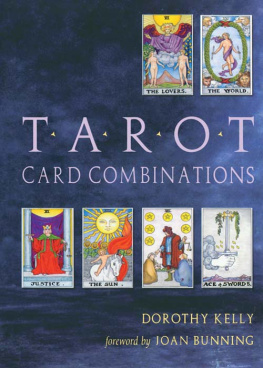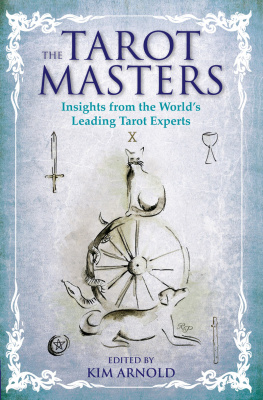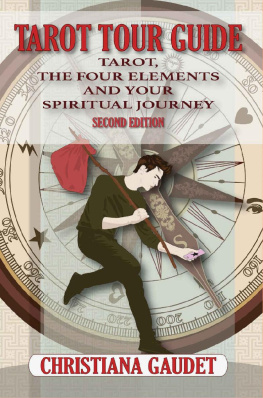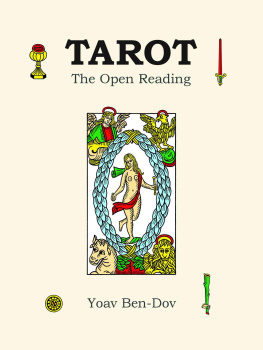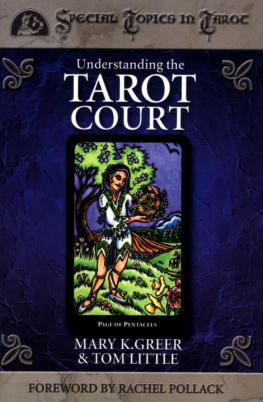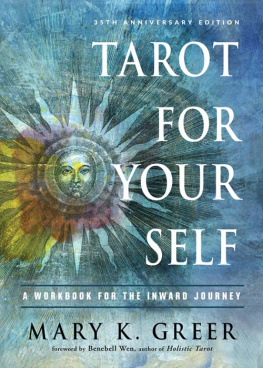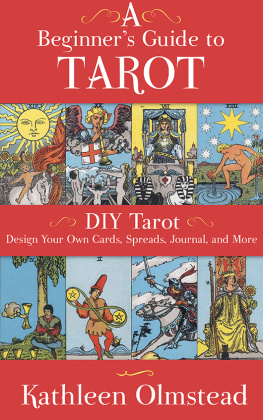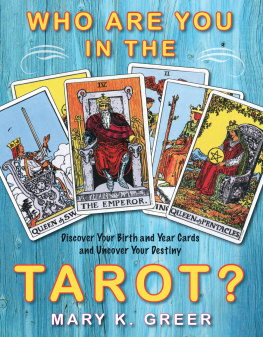The Buddha in the Tarot
Buddhist Reflections on the Major Arcana
Paul Greer
Createspace
Copyright 2017 Paul Greer
All rights reserved.
Thank you to Michael Welton for his kind permission to quote an excerpt from his article Can Buddhism Save the World? at http://www.counterpunch.org/2016/01/15/can-buddhism-save-the-world/.
All extended quotations of Buddhist and Hindu materials were sourced from public domain sites, especially www.sacred-texts.com.
All Biblical quotations are from the Revised Standard Version.
Cover Image: Taoist Sage in the Mountains (stock image no. 117111903); license for commercial use obtained from stock.adobe.com.
Contact Paul Greer at Augustine196785@gmail.com
ISBN-13: 978-1542598101
ISBN-10: 1542598109
Contents
General Introduction
The Fool (0)
The Way of the World
Introduction
The Magician (1)
The High Priestess (2)
The Empress (3)
The Emperor (4)
The Hierophant (5)
The Lovers (6)
The Chariot (7)
Departure and Trials
Introduction
Strength (8)
The Hermit (9)
The Wheel of Fortune (10)
Justice (11)
The Hanged Man (12)
Death (13)
Temperance (14)
The Devil (15)
The Tower (16)
The Return
Introduction
The Star (17)
The Moon (18)
The Sun (19)
Judgement (20)
The World (21)
Notes
General Introduction
Buddha, Tarot and Me
From what I have read, it seems almost customary for Tarot authors to include some reflections on their own personal journeys with the cards; how the relationship began, and how it has developed over time. Not wanting to break with tradition I will do the same here; although I wish to start with some words on Buddhism before moving on to discuss the Tarot.
I was first introduced to Buddhism as a Religious Studies undergraduate in the 1980s, and despite forays into other areas of research and spirituality, it remains for me one of the most accurate, compelling and insightful accounts of the human condition that has ever been formulated. And, although I would not count myself as a card-carrying Buddhist, Buddhism remains a significant factor in my life, and continues to shape my ethical values and my understanding of humanity and existence in general. It has also been my privilege to teach Buddhism to A Level students for the last twenty years or so; although my discussions on impermanence and emptiness have perhaps generated more perplexity and angst than insight.
My relationship with Tarot is a different matter. My first recollection of the deck was as a youngster, watching a television series of fictional short stories entitled Tales of the Unexpected , where the cards appeared on a slowly revolving carousel during the closing credits, accompanied by images of a revolver, the silhouette of an erotically-dancing woman, a glowing African tribal mask, and a roulette wheel. This rather eerie but captivating vignette remains in my mind to this day.
As an undergraduate I decided to join an Occult mail-order book club, on the basis that they would send me three complementary gifts. The first was Doreen Valientes Natural Magic ; an early Wiccan work from the seventies, and one that still commands much respect today. Of particular interest was a chapter entitled Magic of the Cards, which gave some background to the art of cartomancy . The second gift was a coffee-table tome, entitled, strangely enough, Cartomancy , written by Alessandro Bellenghi. Like most books of its kind, it was designed to provide the enthusiastic neophyte with a brief history of card divination, an introduction to Tarot symbolism, and a basic guide to a few commonly-used spreads. The book itself was paired with the third and final gift, and, if I am frank about it, the one I was really after a 1983 Carti Mundi reproduction of the 1770 Vandenborre Bacchus Tarot deck.
With Valiente, Bellenghi and the Vandenborre deck in hand, I set off into the mysterious world of the Tarot. To be honest, my first steps into this strange place were not as straightforward as I had hoped they would be. The Vandenborre deck is not the best to learn from, as it contains a number of significant departures from the more commonly-used images of the Major Arcana. The High Priestess card is replaced by a swaggering braggart by the name of LeEspagnol Captana Earcasse - The Spanish Captain . The rather sober Hierophant is usurped by Bacchus himself, sitting on a cask, quaffing a huge carafe of wine. Other modifications include The Hanged Man shown standing on his feet, and The Tower transformed into a tree, re-titled La Foundre (Thunder). This, accompanied with a lack of imagery on the pip cards and the murky woodblock rendering, made for difficult reading. I persisted however, and eventually produced some insightful readings for my friends and family. Yet, I was always a little uneasy with the practice of divination, and felt a real desire to engage with The Devils Picture Book in some other way.
Work and family life relegated the cards to the bottom of a dusty bookcase until, in 2012, I decided to commit myself to the Tarot once more. This time, I went about my task in a more rigorous and systematic fashion, reading as much as I could, and purchasing better decks. By this time my focus has shifted from divination to a more therapeutic and contemplative approach towards the cards, inspired in much part by Jungian opinions about what the Tarot was really about.
I began, quite casually at first, to notice some interesting parallels between Buddhism and the Tarot cards, particularly those of the Major Arcana. The life of the historical Buddha in particular seemed to mirror a surprising number of images found on the cards. Additionally, many concerns and attitudes which are central to the Buddhist worldview such as wisdom, compassion, effort, resolve, renunciation, balance, and of course, enlightenment - also began to find some resonance with the deck.
My personal discovery of correspondences between Buddhism and Tarot provided one of the inspirations for writing this book, and my overall aim is to offer a series of Buddhist reflections on the Tarot, with particular attention given to the cards of the Major Arcana. However, before I delve into discussing other motivations behind this project, I feel it is necessary at this point to provide some background especially for the uninitiated into that strange and wonderful world that is Buddhism.
The World of Buddhism
The religion of Buddhism is founded on the teachings of Gotama Buddha , who lived and died two-and-a-half thousand years ago. Born the son of a northern-Indian King, Prince Siddhattha Gotama spent his youth surrounded by luxury and sensual delight. With a growing awareness of lifes pains and hardships, and moved with compassion for others, he left his pampered life at the age of twenty-nine and set out on a quest to find a solution to the problems of suffering. After six years of intense spiritual struggle he had an experience of awakening, and was henceforth known as The Buddha - The Enlightened One . He spent the remaining forty-five years of his life teaching and engaging with any who would listen, and establishing a community ( Sangha ) that would practice and continue his doctrine of liberation (Dharma ). He died at the age of eighty, perhaps as a result of unintentional food-poisoning.
There are two main branches of classical Buddhism. Theravada or the Tradition of the Elders is a branch that holds to the words and teachings of the Buddha found in the Pali scriptures, which many view as representing some of the earliest Buddhist teachings. This is a form of Buddhism still practiced in Thailand, Sri Lanka, and Myanmar, among other places. Mahayana or the Great Vehicle is an umbrella term applied to forms of Buddhism that display a number of doctrinal developments from earlier teachings. Some of these teachings are so unique that certain scholars make a further division between Mahayana and Vajrayana ( Diamond Vehicle ) Buddhism. Mahayana Buddhism is associated with the Buddhism of China, Japan, Vietnam, Bhutan, and Tibet, among other places.


